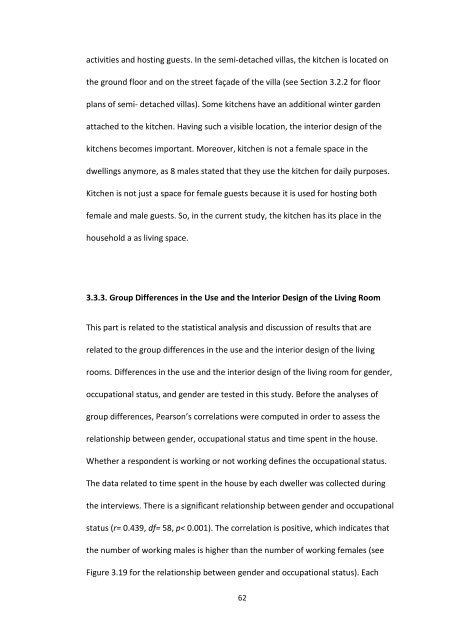private and public use of the living room - Bilkent University
private and public use of the living room - Bilkent University
private and public use of the living room - Bilkent University
You also want an ePaper? Increase the reach of your titles
YUMPU automatically turns print PDFs into web optimized ePapers that Google loves.
activities <strong>and</strong> hosting guests. In <strong>the</strong> semi-detached villas, <strong>the</strong> kitchen is located on<br />
<strong>the</strong> ground floor <strong>and</strong> on <strong>the</strong> street façade <strong>of</strong> <strong>the</strong> villa (see Section 3.2.2 for floor<br />
plans <strong>of</strong> semi- detached villas). Some kitchens have an additional winter garden<br />
attached to <strong>the</strong> kitchen. Having such a visible location, <strong>the</strong> interior design <strong>of</strong> <strong>the</strong><br />
kitchens becomes important. Moreover, kitchen is not a female space in <strong>the</strong><br />
dwellings anymore, as 8 males stated that <strong>the</strong>y <strong>use</strong> <strong>the</strong> kitchen for daily purposes.<br />
Kitchen is not just a space for female guests beca<strong>use</strong> it is <strong>use</strong>d for hosting both<br />
female <strong>and</strong> male guests. So, in <strong>the</strong> current study, <strong>the</strong> kitchen has its place in <strong>the</strong><br />
ho<strong>use</strong>hold a as <strong>living</strong> space.<br />
3.3.3. Group Differences in <strong>the</strong> Use <strong>and</strong> <strong>the</strong> Interior Design <strong>of</strong> <strong>the</strong> Living Room<br />
This part is related to <strong>the</strong> statistical analysis <strong>and</strong> discussion <strong>of</strong> results that are<br />
related to <strong>the</strong> group differences in <strong>the</strong> <strong>use</strong> <strong>and</strong> <strong>the</strong> interior design <strong>of</strong> <strong>the</strong> <strong>living</strong><br />
<strong>room</strong>s. Differences in <strong>the</strong> <strong>use</strong> <strong>and</strong> <strong>the</strong> interior design <strong>of</strong> <strong>the</strong> <strong>living</strong> <strong>room</strong> for gender,<br />
occupational status, <strong>and</strong> gender are tested in this study. Before <strong>the</strong> analyses <strong>of</strong><br />
group differences, Pearson’s correlations were computed in order to assess <strong>the</strong><br />
relationship between gender, occupational status <strong>and</strong> time spent in <strong>the</strong> ho<strong>use</strong>.<br />
Whe<strong>the</strong>r a respondent is working or not working defines <strong>the</strong> occupational status.<br />
The data related to time spent in <strong>the</strong> ho<strong>use</strong> by each dweller was collected during<br />
<strong>the</strong> interviews. There is a significant relationship between gender <strong>and</strong> occupational<br />
status (r= 0.439, df= 58, p< 0.001). The correlation is positive, which indicates that<br />
<strong>the</strong> number <strong>of</strong> working males is higher than <strong>the</strong> number <strong>of</strong> working females (see<br />
Figure 3.19 for <strong>the</strong> relationship between gender <strong>and</strong> occupational status). Each<br />
62
















